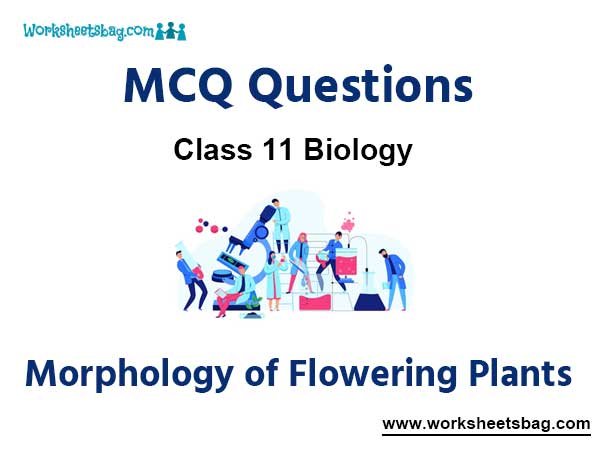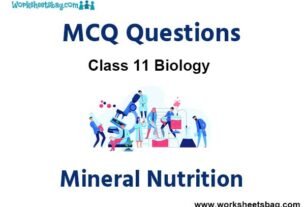Please refer to Morphology of Flowering Plants MCQ Questions Class 11 Biology below. These MCQ questions for Class 11 Biology with answers have been designed as per the latest NCERT, CBSE books, and syllabus issued for the current academic year. These objective questions for Morphology of Flowering Plants will help you to prepare for the exams and get more marks.
Morphology of Flowering Plants MCQ Questions Class 11 Biology
Please see solved MCQ Questions for Morphology of Flowering Plants in Class 11 Biology. All questions and answers have been prepared by expert faculty of standard 11 based on the latest examination guidelines.
MCQ Questions Class 11 Biology Morphology of Flowering Plants
Question- Pneumatophores are found in
(a) the vegetation which is found in marshy and saline lake.
(b) the vegetation which is found in saline soil.
(c) xerophytic condition.
(d) hydrophytic condition.
Answer
A
Question- Which of the following is a modified stem for the protection of plants from browsing animals?
(a) Tendrils
(b) Thorns
(c) Rhizome
(d) Tuber
Answer
B
Question- Perisperm is
(a) remnant of endosperm
(b) persistant nucellus
(c) remnant of embryo
(d) part of endosperm
Answer
B
Question- A mature ligule, having a prominent basal portion, is called
(a) glossopodium
(b) rhizophore
(c) trichome
(d) None of these
Answer
A
Question- Inflorescence of Ficus is
(a) spike
(b) hypanthodium
(c) raceme
(d) verticillaster
Answer
B
Question- Most reduced form of stem is found in
(a) bulb
(b) rhizome
(c) tree
(d) stem
Answer
A
Question- Clove is
(a) flower bud
(b) axillary bud
(c) thalamus
(d) ovule
Answer
A
Question- Pollinia are found in
(a) wheat
(b) madar
(c) mango
(d) banana
Answer
B
Question- Monocarpic plants flower
(a) once
(b) twice
(c) many times
(d) never
Answer
A
Question- In which family (9) + 1 androecium condition is found ?
(a) Malvaceae
(b) Papilionaceae
(c) Solanaceae
(d) Poaceae
Answer
B
Question- Which of following type of anther is found in Malvaceae?
(a) Monothecous
(b) Dithecous
(c) Polythecous
(d) Without thecous
Answer
A
Question- Potato and sweet potato
(a) have edible parts which are homologous organs.
(b) have edible parts which are analogous organs.
(c) have been introduced in India from the same place.
(d) are two species of the same genus.
Answer
B
Question- The sugarcane plant has
(a) dumb-bell shaped guard cells
(b) pentamerous flowers
(c) reticulate venation
(d) capsular fruits
Answer
A
Question- The family containing mustard and its main characters are
(a) Brassicaceae – Tetramerous flowers, six stamens, bicarpellary gynoecium, siliqua type fruit
(b) Brassicaceae – Pentamerous flowers, many stamens, pentacarpellary gynoecium, capsule type fruit
(c) Solanaceae – Pentamerous flowers, five stamens, bicarpellary gynoecium, berry type fruit
(d) Poaceae – Trimerous flowers, three stamens, monocarpellary gynoecium,caryopsis type of fruit
Answer
A
Question- Velamen present in orchids help in
(a) absorbing water from support
(b) respiration
(c) absorption of moisture from air
(d) synthesizing food
Answer
C
Question- Composite fruit develops from
(a) single ovary
(b) inflorescence
(c) apocarpous ovary
(d) pericarp
Answer
B
Question- If the anthers are fused together forming a tubular structure while the filaments remain free,the condition is found in which one of the following family?
(a) Malvaceae
(b) Cucurbitaceae
(c) Solanaceae
(d) Asteraceae
Answer
D
Question- Fibrous roots develop in maize from
(a) upper nodes
(b) lower nodes
(c) upper internodes
(d) none of these
Answer
B
Question- Which of the following groups of plants have underground stems?
(a) Potato, ginger, turmeric, Euphorbia, zaminkand
(b) Potato, ginger, turmeric, zaminkand, Colocasia
(c) Potato, Citrus, Opuntia, zaminkand, Colocasia
(d) Potato, cucumber, watermelon, zaminkand,Colocasia
Answer
B
Question- The edible part of cauliflower is
(a) inflorescence
(b) leaf
(c) flower
(d) stem
Answer
A
Question- Floral diagram fails to indicate
(a) epiphylly and epipetaly
(b) aestivation and placentation
(c) position of ovary on the thalamus
(d) cohesion of carpels and stamens
Answer
C
Question- Fern character of Cycas is
(a) coralloid root
(b) tap root
(c) parallel venation
(d) circinate venation
Answer
D
Question- Of the following, which instrument is most commonly used to observe the external features of a grasshopper’s abdomen?
(a) Ultracentrifuge
(b) Microdissection instrument
(c) Dissecting microscope
(d) Electron microscope
Answer
C
Question- The desert plants in order to tolerate water stress show
(a) sunken stomata
(b) reduced leaves
(c) well developed root system
(d) all of these
Answer
D
Question- Nodules with nitrogen fixing bacteria are found in
(a) cotton
(b) gram
(c) mustard
(d) wheat
Answer
B
Question- Which of following type of anther is found in Malvaceae?
(a) Monothecous
(b) Dithecous
(c) Polythecous
(d) Without thecous
Answer
A
Question- In moss capsule, the number of peristome whorls are
(a) 1
(b) 2
(c) 3
(d) 4
Answer
B
Question- The regions of the stem where leaves are borne are called____________ while ____________ are the portions between two ____________.
(a) nodes, nodes and internodes
(b) nodes, internodes and nodes
(c) internodes, nodes and nodes
(d) internodes, internodes and nodes
Answer
B
Question- Prickles of rose are
(a) Modified leaves
(b) Modified stipules
(c) Exogenous in origin
(d) Endogenous in origin
Answer
C
Question- Which of the following are not characteristic features of fabaceae?
(a) Tap root system, compound leaves and raceme inflorescence.
(b) Flowers actinomorphic, twisted aestivation and gamopetalous.
(c) Stamens 10, introrse, basifixed, dithecous.
(d) Monocarpellary, ovary superior and bent stigma.
Answer
B
Question- Which one of the following is correctly matched?
(a) Onion – Bulb
(b) Ginger – Sucker
(c) Chlamydomonas – Conidia
(d) Yeast – Zoospores
Answer
A
Question- Read the following statements.
(i) Gynoecium is situated in the centre and other parts of the flower are located on the rim of the thalamus almost at the same level.
(ii) Ovary is half-inferior.
(iii) Examples are plum, rose and peach.
Which condition of flowers is being described by the above statements ?
(a) Hypogyny
(b) Perigyny
(c) Epigyny
(d) None of these
Answer
B
Question- Aggregate fruit develops from
(a) syncarpous ovary
(b) multicarpellary, syncarpous ovary
(c) unilocular ovary
(d) multicarpellary, apocarpous ovary
Answer
D
Question- Match the following-
List-I List-II
A. Coleorhiza I. Development of sporophyte directly from gametophyte
without intervention of gametes
B. Apogamy II. Development of gametophyte directly from sporophyte
without the involvement of reduction division.
C. Indusium III. An unbranched columnar stem with a crown of leaves.
D. Caudex IV. Protective covering of radicle
V. Protective structure of a sorus.
(a) A – V; B – II; C – IV; D – I
(b) A – IV; B – I; C – V; D – III
(c) A – III; B – V; C – II; D – IV
(d) A – II; B – III; C – I; D – V
Answer
B
Question- Root differs from stem in having
(a) nodes and internodes
(b) axillary buds
(c) multicellular hairs
(d) unicellular hairs
Answer
D
Question- Leaves of dicotyledonous plants possess _________ venation, while _________ venation is the characteristic of most monocotyledons.
(a) reticulate and parallel
(b) parallel and reticulate
(c) reticulate and perpendicular
(d) obliquely and parallel
Answer
A
Question- Which of the following plant parts elongates directly and leads to the formation of primary roots?
(a) bud
(b) radicle
(c) plumule
(d) root hair
Answer
B
Question- The primary roots and its branches constitute the
(a) fibrous root system.
(b) tap root system.
(c) adventitious root system.
(d) all of the above
Answer
B
Question- Fibrous root system is found in
(a) monocotyledonous plants.
(b) dicotyledonous plants.
(c) bryophytes.
(d) gymnosperms.
Answer
A
Question- In a bisexual flower, if androecium and gynoecium mature at different times, the phenomenon is known as a
(a) dichogamy
(b) herkogamy
(c) heterogamy
(d) monogamy
Answer
A
Question- Root hairs develop from
(a) region of maturation
(b) region of elongation
(c) region of meristematic activity
(d) root cap
Answer
A
Question- Parachute type dispersal occurs in
(a) tomato
(b) mustard
(c) pea
(d) cotton
Answer
B
Question- Which of the following is a modified stem for the protection of plants from browsing animals?
(a) Tendrils
(b) Thorns
(c) Rhizome
(d) Tuber
Answer
B
Question- Prop roots of banyan tree are meant for
(a) respiration.
(b) absorption of water from soil.
(c) providing support to big tree.
(d) all of the above.
Answer
C
Question- Stilt roots occur in __________ .
(a) groundnut
(b) rice
(c) sugarcane
(d) wheat
Answer
C
Question- Which of the following plants grow in swampy areas,where the roots come out of the ground and grow vertically upwards?
(a) Potato
(b) Opuntia
(c) Rhizophora
(d) Grass
Answer
C
Question- The part of the root which is most active in water absorption is called
(a) root cap
(b) maturation zone
(c) meristematic zone
(d) zone of elongation
Answer
B
Question- Which of the following plant parts is generally green when young and later often becomes woody and dark brown?
(a) stem
(b) seed
(c) leaves
(d) flower
Answer
A
Question- The presence of cilia, an oral groove, and food vacuoles, and the absence of chloroplasts in a unicellular organism indicate that the organism carries on
(a) sexual reproduction
(b) autotrophic nutrition
(c) extracellular digestion
(d) heterotrophic nutrition
Answer
D
Question- Roots develop from parts of the plant other than radicle are called
(a) tap roots
(b) fibrous roots
(c) adventitious roots
(d) nodular roots
Answer
C
Question- Stem tendrils are found in
(a) cucumber
(b) pumpkins
(c) grapevines
(d) all of these
Answer
D
Question- In Opuntia, spines are modification of
(a) stem
(b) root
(c) leaf
(d) flower
Answer
C
Question- Seeds are adaptively important because
1. they maintain dormancy
2. they protect young plants during vulnerable stages
3. they store food for young plants, and facilitate dispersal
(a) 1 and 3
(b) 2 and 3
(c) 1 and 2
(d) All of these
Answer
D

